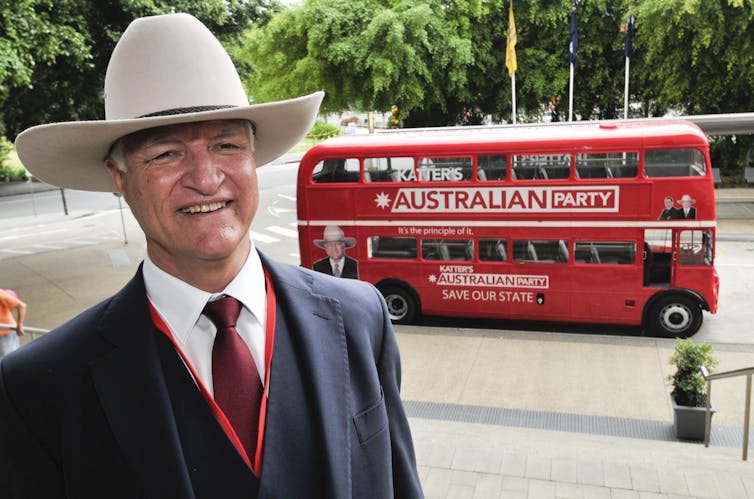We’ve never been to one or the other, but we presume that Silvio Berlusconi’s and Bob Katter’s house parties are pretty different affairs.
Their political parties are another matter, however. The former Italian prime minister, as famous for his private life as his public one, and Katter, known around Australia for his off-colour remarks and enormous Akubra hat, are both leaders of a type of political party – the personal party – which revolves almost entirely around the political success and longevity of the “founder-leader”.
Berlusconi and Katter may make strange bedfellows, but they represent a shift in how political parties are created and operate in Western democracies. While leaders have usually been the expressions of parties, personal parties like the PDL and KAP turn the formula on its head, with the party being the expression of the leader.
Given the personalisation of politics and the decline of traditional party organisational models, this trend will almost certainly continue - Julian Assange’s WikiLeaks Party may well be the next Australian case.
Taking as examples the two parties Berlusconi has founded - Forza Italia (FI) and its successor the Popolo della Libertà (PDL) - one of the authors of this article, Duncan McDonnell, set out the main criteria for identifying a personal party in a recent Political Studies article.
These include the party’s expected lifespan being seen - even by most of those within it - as dependent on the political lifespan of the founder-leader and organisation at local level being neither constantly manifest nor permanent: the party is not built to outlast its creator.
The party’s image and campaign strategies tend to be centred on the founder-leader, who also wields an extremely high degree of formal and/or informal power.
While some parties may fulfil a number of these criteria, it is their combined presence – and in particular the first one concerning the party’s expected lifespan – which distinguishes a personal party from one which is simply personalised in its communications and power structures.

In the case of FI and the PDL, all of these key criteria have been very clearly present. Party statutes have put enormous powers in Berlusconi’s hands, as demonstrated by the fact that he has been able to select candidates and invent new positions in the party hierarchy at the drop of a hat. Likewise, party communications and campaigns have constantly focused on Berlusconi – not only in national elections, but even in regional contests where he was not standing as a candidate.
As for the first two criteria: in interviews with PDL elected representatives and ordinary members across Italy, less than a quarter of respondents stated unequivocally that they believed the party would have a post-Berlusconi future. “No Silvio, no party” was the dominant message.
Interviewees also confirmed that – despite the PDL’s claims to have over one million members – in reality, little had been done to organise at grassroots level. It is a party which, as many representatives openly stated, inflates at campaign time and deflates afterwards, with only those elected remaining. As one PDL senator commented in an interview, Berlusconi’s “ideal is a party which does not give him too much cause for concern, which basically exists to provide him with power”.
While Berlusconi may be the most successful personal party leader in a Western democracy, he is by no means the only one.
Most recently in Australia, the emergence of Katter’s Australian Party looks to be fitting the personal party model to a tee. Registered in September 2011, and already with two seats in the Queensland parliament, the party seems set to pick up a number of Senate seats in the September federal election. So how does it tick the boxes of a personal party?
First, Katter looms large over the party. His image and personality is stamped all over the KAP’s campaign materials and website, even down to the very name over the party – it’s Katter’s Australian Party, not someone else’s. The use of other candidates in such material has been minimal.
Katter also appears to enjoy extremely strong power within the party, with one report indicating that KAP is a “one man band” and that Katter has final say over candidates’ selection, and other reports accusing him of bullying tactics within the party.
Despite the promise to run candidates in every seat for the upcoming election, the organisation of the party appears to be haphazard – according to KAP’s website, beyond the National Office, the KAP only has a State Office in Victoria, and just one local branch, in Lockyer, Queensland.

And well-publicised internal spats, resignations and controversies have all become a regular feature of KAP’s short existence. These organisational black spots indicate that KAP might not have too much fuel in the tank in terms of its chances of longevity, especially if Katter bows out sometime in the future.
On that point, it is unclear if or how KAP would continue beyond the political lifespan of Katter. When asked about this by Louis Nowra in a recent interview for The Monthly, Katter claimed that “Gaullism survived the death of de Gaulle”, and as such, KAP could continue beyond Katter, with the suggestion being that his son, Rob Katter, might take over the reins.
However, this seems doubtful, given Rob’s “misgivings about politics”. And, in any case, Katter’s Australian Party is a made-to-measure party, designed to fit its leader and founder. It would almost certainly sag on anyone else.
Returning to Europe, Geert Wilders’ Freedom Party in the Netherlands seems another clear case of a personal party: indeed, Wilders is the only official member.
Moving further afield, the United States saw the rise (and fall) of Ross Perot’s Reform Party in the 1990s. At home, Pauline Hanson’s parties – One Nation and Pauline’s United Australia Party – also fit the bill, with the lawsuits that followed One Nation’s peak success revealing the highly undemocratic levels of power held by Hanson and her key staff.
Such parties, creations and reflections of their leaders rather than vice-versa, will continue to emerge in Western democracies as traditional types of party organisations decline and political competition becomes more personalised. So, while Bob and Silvio will leave eventually, the personal party is unlikely to end any time soon.

